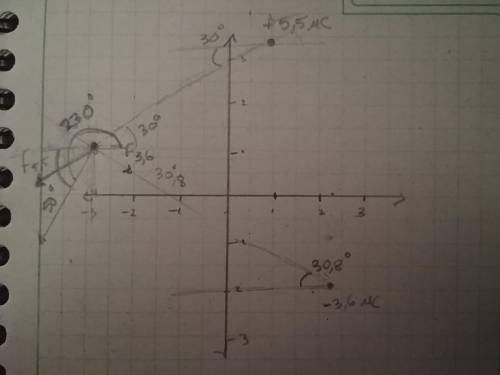
Physics, 02.09.2019 21:30 karizm2010
A5.5-µc point charge is located at x = 0.9 m, y = 3.4 m, and a -3.6-µc point charge is located at x = 2.3 m, y = -1.9 m.
(a) find the magnitude and direction of the electric field at x = -2.9 m, y = 1.2 m.
magnitude kn/c:
direction °:
(b) find the magnitude and direction of the force on a proton at x = -2.9 m, y = 1.2 m.
magnitude n :
direction ° :

Answers: 3


Another question on Physics

Physics, 21.06.2019 22:00
Jason and mia are both running in a race. as they approach the finish line, you being the physicist that you are decide to time how long it takes them to reach the end of the race. when you start your stop watch (you can take this as time t = 0 s) you notice that mia is an unknown distance d ahead of jason and both are moving with the same initial velocity v_0. you also notice that jason is accelerating at a constant rate of a_j, while mia is deaccelerating at a constant rate of -a_m. jason and mia meet each other for the first time at time t = t_1. at this time (t = t_1) jason's velocity is two times that of mia's velocity, meaning v_j (t_1) = 2v_m (t_1). a) draw the position vs. time graph describing mia's and jason's motion from time t = 0 to time t = t_1. clearly label your axes and initial conditions on your graph. b) draw the velocity vs. time graph describing mia and jason's motion from time t = 0s to time t = t_1. clearly label your axes and initial conditions on your graph. c) how long from when the stop watch was started at t = 0s did it take mia and jason to meet? express your answer in terms of know quantities v_0, a_m, and a_j. d) when the stop watch started at time t = 0s, how far apart, d, were mia and jason? express your answer in terms of know quantities v_0, a_m, and a_j.
Answers: 1

Physics, 22.06.2019 01:00
First, launch the video below. you will be asked to use your knowledge of physics to predict the outcome of an experiment. then, close the video window and answer the question at right. you can watch the video again at any point. part a as in the video, we apply a charge +q to the half-shell that carries the electroscope. this time, we also apply a charge –q to the other half-shell. when we bring the two halves together, we observe that the electroscope discharges, just as in the video. what does the electroscope needle do when you separate the two half-shells again? view available hint(s) as in the video, we apply a charge + to the half-shell that carries the electroscope. this time, we also apply a charge – to the other half-shell. when we bring the two halves together, we observe that the electroscope discharges, just as in the video. what does the electroscope needle do when you separate the two half-shells again? it deflects more than it did at the end of the video. it deflects the same amount as at end of the video. it does not deflect at all. it deflects less than it did at the end of the video. submit
Answers: 2

Physics, 22.06.2019 12:50
Assume you measured the mass of the cart to be (500 ± 1) g and the mass of the additional mass you put on the cart to be (500 ± 1) g as well. since the scale you are using in the lab cannot measure objects heavier than 600g you will have to sum up individual pieces and propagate the error. so what would be the mass and the standard error of the cart and the mass
Answers: 3

Physics, 22.06.2019 15:30
What is the increase in density of a medium due to wave travel?
Answers: 2
You know the right answer?
A5.5-µc point charge is located at x = 0.9 m, y = 3.4 m, and a -3.6-µc point charge is located at x...
Questions


Mathematics, 22.07.2019 02:30

Advanced Placement (AP), 22.07.2019 02:30

Biology, 22.07.2019 02:30



History, 22.07.2019 02:30



Computers and Technology, 22.07.2019 02:30



Mathematics, 22.07.2019 02:30


Mathematics, 22.07.2019 02:30

Social Studies, 22.07.2019 02:30

Business, 22.07.2019 02:30

Chemistry, 22.07.2019 02:30


Biology, 22.07.2019 02:30


 direction=
direction= 









 , because is going down and to the left, we have to add 180, so the direction is=
, because is going down and to the left, we have to add 180, so the direction is=



